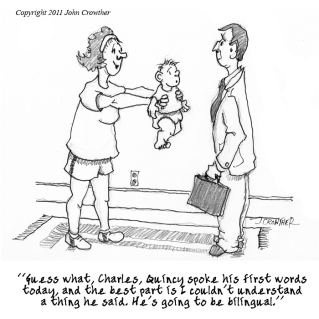In late 2002 or early 2003, when I was living in Italy and before the thought of seriously writing in Spanish had ever occurred to me, I wrote a short story called “The Francophone Baby”. This was the era of the run-up to the Iraq War, let us recall, when nativists were rushing to subsitute “freedom” for “French” in our fries, much as their great-grandparents had tried taking the linguistic knife to sauerkraut and hamburgers a hundred years before in the context of World War I – and with the same success. I don’t recall that I planned it the way, but the story of an all-American family who freaks out becasue their baby is born inexplicably speaking French turned out to be delightfully timely.
More than political, however, the story was inspired by my reading of the work of Joseph Chilton Pearce, in particular his book Magical Child, which discusses the importance of the mother-child bond which forms, in part, by the fetus synchronzing right from the womb with the mother’s speech pattern (a fact I put into the mouth of my fictional pediatrician). Pearce has written extensively on the breakdown of that fundamental bond, and children’s subsequent development, through such factors as hospital birthing, television and day care. So “The Francophone Baby” itself was born as a thought experiment of what might happen if this rupture were taken, not to its logical extreme but to its illogical one.
The story was published in the online magazine “The Adirondack Review” in that same 2003 under the admittedly clunky pseudonym of Archibald Graham, the doctor played by Burt Lancaster in the movie Field of Dreams. And there the story sat, basically ignored, until I began my first serious attempts to publish in Mexico five or so years later. As is logical, I started out by translating some of the stories I already had, and as “The Francophone Baby” was short and possessed the advantage of having already been published, I started there. The first translation of the story was published in 2008 in El Ciclo Literario.
A couple of years later, as I began gathering together the material that would become Interrumpimos este programa (in English, We Interrupt This Program), I revisted the translation, both expanding the dialogues and making some key changes to the translation itself:
- Tweaking Mr. Johnson’s idiomatic language. Although a Mexican character in as agitated a state as Johnson might very well say pendejadas and maricones, the character is, in fact, American. This is a conundrum I have come back to over and over again in my writing since: how to render the idiomatic language of a character when the language he is presumably speaking within the story is different from the one the story itself is written in?
- Re-translating the language joke. In the original English version, the language spoken by one of the babies is the hypothesized root language of humanity: the Ur-language. But whenever someone says the word Ur, Mr. Johnson accuses them of trailing off (my homage, conscious or unconscious, to Eric Idle’s reading of the cave script in Monty Python and the Holy Grail). As the joke does not translate, I have Mrs. Johnson confusing the Spanish equivalent of the hypothesized language, proto-sapiens, with the much more common term homo sapiens.
- Integrating the story with the rest of the collection. As I put the collection together, the idea gradually ocurrred to me of finding a way to link the stories together, to interlace them. As baby Jacques recurs later in the book as an adult in a specific geographical location, I found it expedient to sell him off to the Province of Quebec instead of France’s Culture Ministry – a switch which wound up eliciting a lively protest from a francophone friend in Montreal!
As it’s turned out, “The Francophone Baby” or, in its Spanish incarnation “El bebé francófono” has become the most popular story in the book by far (not least due to the fact that it’s the first and shortest story), and my go-to story for most readings. As an interesting mini-case study in the evolution of stories and their translations over time, following are links to the three versions of the story:
1.) The original English version in the Adirondack Review.
2.) The 2008 translation in El Ciclo Literario.
3.) The final published version in Interrumpimos este programa.
Until next time!
